The card game Golf takes it's name from the fact that each player attempts to end each hand and the game with the fewest number of points as in the sport of the same name. The game is also sometimes known under
various other names such as Polish Polka, Nine Holes, or Turtle. This game should not be confused with the Solitaire card game which also bears this same name. That game is described at this
link.
There are variants of this game featuring various numbers of cards in the player's layouts, but the four card version will be described first. For versions of the game using differing number of cards as well as other modified versions of the game, see the variations section below.
Four card Golf is designed to be played by 2 to 8 players using one standard deck. Although the cards, for purposes of this game are not ranked, each card does have a point value which is used for calculating scores at the end of each hand. The following chart shows the point value of each card in the deck:
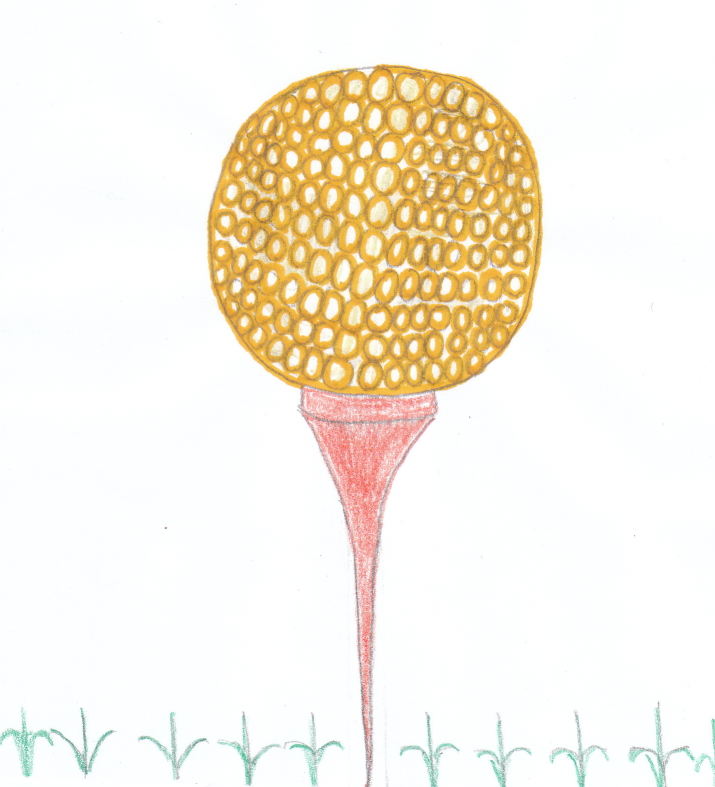 |
|
| Card | Point Value |
|---|
| Ace | 1 |
| 2, 3, 4, 5, 6, 7, 8, 9, 10 | Face value marked on card |
| Jack, Queen | 10 |
| King | 0 |
|
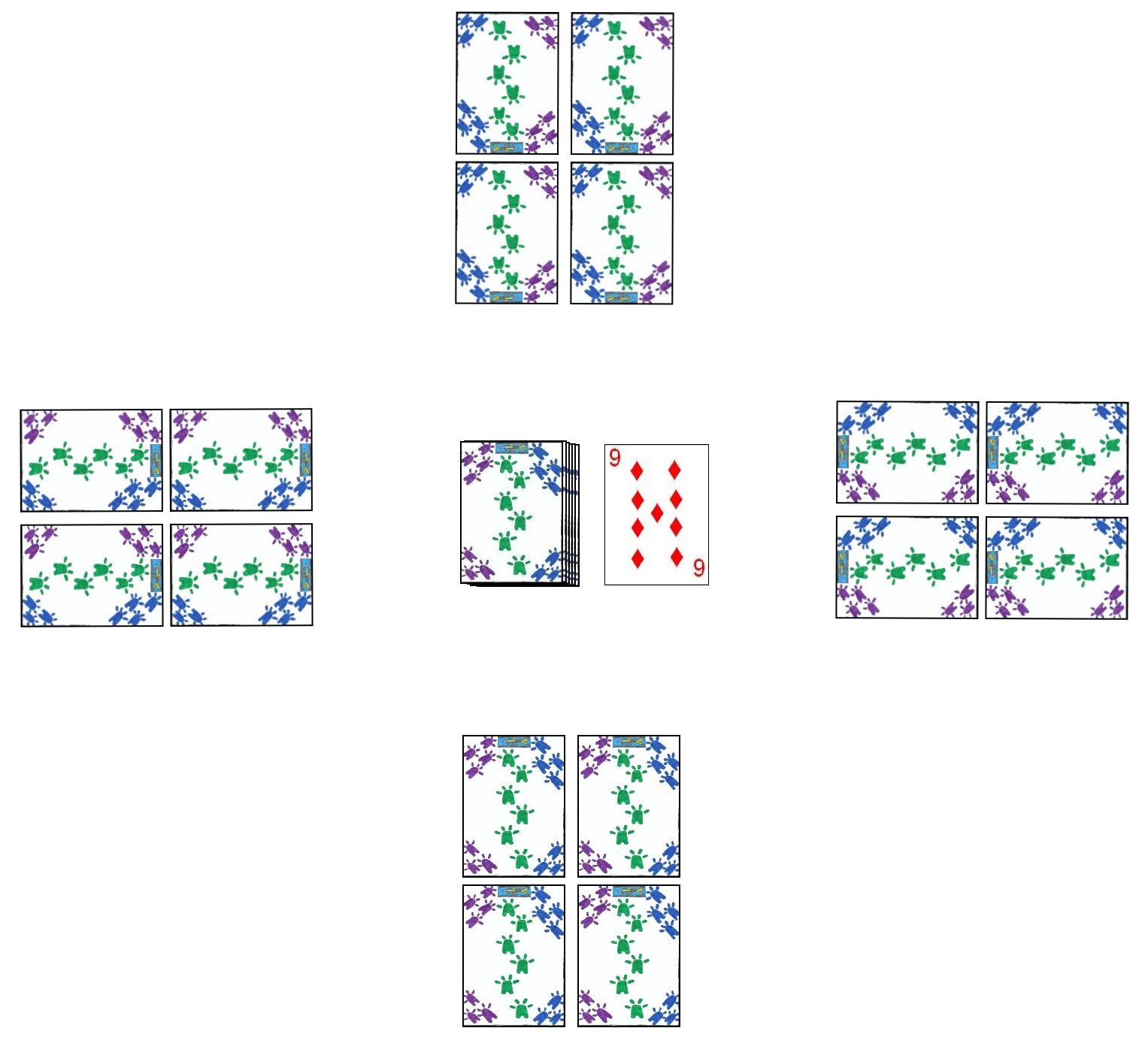
Determination of the first dealer and seating positions can be performed using a number of methods, with drawing for low cards a common method. The players would take seats at the table in order based on the point value of the card drawn, from lowest point value to the highest. The player drawing the lowest point total card becomes the first dealer. If two or more players draw cards with the same point value, those players should discard the card and draw again, continuing to do so until drawing a card no other player has yet drawn.
Once the players are seated and the dealer selected, the dealer thoroughly
shuffles the deck and offers it to the player at his right to cut. After the
cut, the dealer then deals four face-down cards to each player one at a time
and in a clockwise rotation, starting with the player at his immediate left.
After the players have received his four card hand, he should arrange them
in a face-down rectangle consisting of two rows of two cards each. When
arranging the cards each player should never view the cards he was dealt. The dealer then places the remainder of the undealt pack in the center of the table as the stock, taking the top card of the stock and laying it face-up beside the stock pile to start the discard pile. Before play begins, each player may then look at the two cards nearest to himself in his own layout, being careful not to show any other player the point value of these cards. Once he looks at these cards he places them back and may no longer look at the values of any of his face-down cards in his layout. In fact, a player may never again, during the hand look at the values of the face-down cards which are part of his layout. The player to the dealer's immediate left has the first turn and play then rotates in a clockwise rotation around the table.
On his turn, a player may take any one of several actions on that turn, as follows, with the
ultimate goal to cause his four card layout to have the lowest total point value of any player in this hand:
- Draw the top card from the stock:
The player draws a card from the top of the face-down stock and looks at it's face. If he does not want to replace any of the cards in his own layout with the card drawn, he may simply discard it, placing it face-up on top of the discard pile. However, if the player elects to replace a card from his layout with the newly drawn card, he may not first look at any of the cards in his layout, but simply takes one of the cards in his layout and places that card face-up on the top of the discard pile, replacing that card with the card just drawn. Once he elects to replace a card he may not change his mind, and must discard the card removed from his layout, replacing it with the card drawn from the stock.
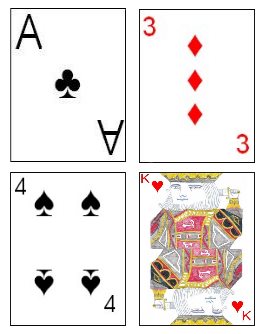
- Draw the top card from the discard pile:
If the player prefers, he may take the top, exposed card on the discard pile, replacing any one of the four cards in his layout with that card. He may not look at the faces of any of the face-down cards in his layout, but simply selects a card from his layout, removing it and placing it face up on the top of the discard pile, and then replacing the removed card with the card drawn from the discard pile at the start of his turn. The player may not change his mind once he has taken the top card of the discard pile and must replace one of the cards from his layout with the drawn card.
- Knock:
If a player is satisfied with what he believes the current total point value of his layout is, the player may knock on his turn. He does this by simply clearly stating "Knock" or rapping on the table with his knuckles such that all players can hear. He makes no other play on this turn. Once one player knocks each remaining player has exactly one more turn to exchange cards from the layout, starting with the next player to the left of the knocking player.
After a player knocks, each additional player in turn after the knocker has one more turn to attempt to improve his hand. In addition, if the last card of the stock is draw, the hand also immediately ends. After the hand ends, the players turn over all the cards in his layout and the cards are scored.
As per the chart above, each card in the players layout is summed to determine his score for this hand (called a hole). Each players total is then added to that players cumulative total over the course of nine holes to make a complete game. After nine holes, the player with the lowest grand total is declared the game winner.
Eighteen Holes: For a longer game (and to mimic a full round of the
actual outdoor sport of Golf), some players prefer to play a total of 18 hands vice the normal 9 in the standard game. Thus, the player with the lowest grand total after all 18 hands is declared the game winner.
Double Deck Golf: In order to accommodate additional players, two decks can be shuffled together for this game. This will comfortably allow up to 16 total players. Other than the additional cards and the additional number of players, the game is played identically to the standard version of Golf.
Columns: Another optional rule that is sometimes used is that of matched columns. This variant features an additional method to reduce the total count of cards in a player's layout. If two cards in a specific column are of the exact same denomination, the cards cancel each other out, providing a score of 0 for those cards. This gives a players a strategic way to attempt to lower the score of his layout. In all other aspects this variant is played identically to the standard game.
Knock Penalty: Another optional rule that is sometimes used is the addition of penalties for the player who knocks if they do not have the lowest total in the hand. If the player who knocks does not have the lowest total for the hand, 10 points are added to his accumulated total (in addition to his regular total for the hand).
Scoring Differences: Some players opt to play the game using a slightly modified scoring table, The following chart shows this alternate scoring for each card in the deck:
| Card | Point Value |
|---|
| Ace | 1 |
| 2, 3, 4, 5, 6, 7, 8, 9, 10 | Face value marked on card |
| Jack | 11 |
| Queen | 12 |
| King | 13 |
Four in the Hand: A variant of Golf which is played, often by new players to the game is Four in the Hand. In this version, instead of using a grid layout on the table, each player simply takes the card he is dealt into his hand. The player may look at the cards at any time, and when drawing may simply replace any card from his hand with the card drawn. If a player has a pair of cards of the exact same denomination, these two cards cancel each other out, with a net score of zero for those two cards. In all other aspects the game is played identically to the standard variation.
Power Card Golf: Power Card Golf is a variant of Golf in which certain cards in the deck have special effects on play.
The game itself is played identically to standard Four Card Golf as described above, with the exception of the Power Cards, and the fact that 2 Jokers are added to the deck. If a player, when drawing from the stock pile, draws a special Power Card from the stock he may elect to add the card to his own layout as normal, giving the normal scoring value for that card, or alternately, the special ability or power of that card can be used by the player. After a player uses a card in this way, he must discard the card to the discard pile, face-up. A card drawn from the stock pile or found a players layout does not inherit any of the special abilities it would have if drawn from the face-down stock. The following are the special abilities certain cards have in the game:
| Power Card | Special Ability |
|---|
| Jack | Allows the player to look at any on of the face-down cards in his own layout. He should ensure no other player sees the face of the card, however. |
| Queen | The player who plays this Power Card can look at one card in any other opponents layout. He should ensure no other players also see the value of the card. |
| King | Playing this Power card allows a player to swap any one card from his own layout with any one card from any opponents layout. The swap is done with both cards left face-down so no one views the cards swapped. |
| Joker | Allows the player to force any one opponent to scramble or shuffle his four card layout, with the cards remaining face-down, thus causing that player to no longer know the specific location of specific cards in his own layout. Note that if a Joker is found in or added to a player's layout, it has a count value of 10 for purposes of scoring
that player's layout. |
In this variant, players are not allowed to knock and the game ends after the last card from the stock pile has been drawn. After that last turn, the player with the lowest total score found in his layout is declared the game winner.
Jacks and Fives: Jacks and Fives is another variant of Four-Card Golf. It is sometimes played under the name "Jacks N' Fives" and sometimes "Jackson Fives". This game is played very similarly to standard Golf, with the following differences:
- Once a player knocks, this immediately ends the game, with no more turns, for any player, occurring after the knock.
- The scoring of each card found in a player's layout after a player knocks is as per the following chart:
| Card | Point Value |
|---|
| Ace | 1 Point Each |
| 2, 3, 4, 6, 7, 8, 9, 10 | Face value marked on card |
| Queen, King | 10 Points Each |
| 5 | 0 |
| Jack | 0 |
- Each hand is usually considered a complete game with the player with the lowest total score of cards in his layout declared that game's winner.
In all other aspects, Jacks and Fives is played identically to standard Four-Card Golf.
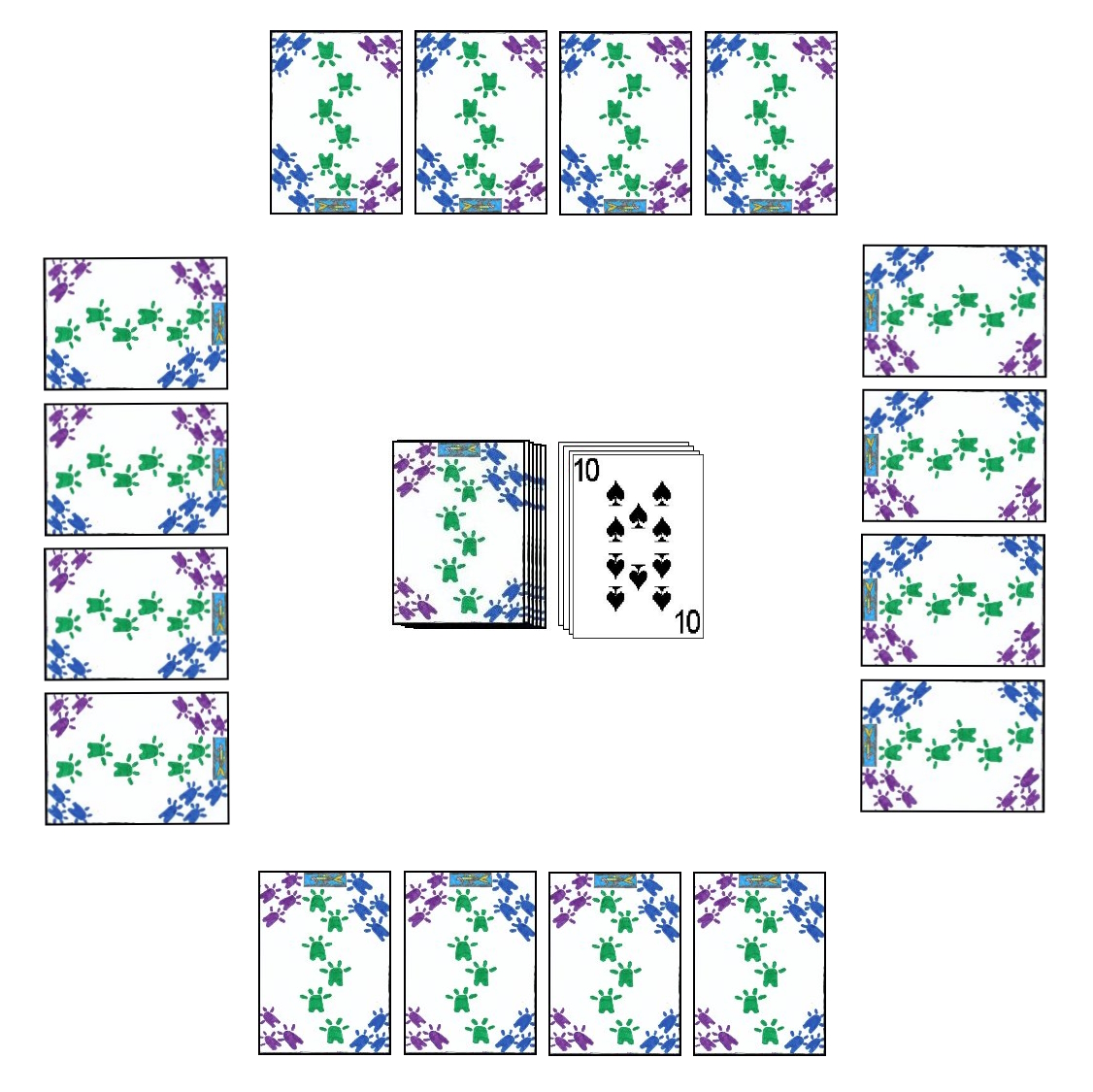 Rat-A-Tat-Tat:
Rat-A-Tat-Tat: Rat-A-Tat-Tat is another game which is played very similarly to Four Card Golf. In fact, the game is identical save for the following few differences:
- The initial layout for each player is dealt in a row of four face-down cards, in front of each player.
- After the deal, each player is entitled to look at the two outermost cards in his layout.
- In replacing a card from his layout with a card from the discard or draw pile, the new card is placed in the layout face-down, and thus the player cannot normally look at the face of this card again.
- Drawing a Jack or Queen from the stock pile entitles the drawer to perform a special action, as follows:
- Drawing a Jack allows the player to look at any one of the cards in his layout. After looking at the card, he then discards the Jack to the discard pile.
- Drawing a Queen allows the player drawing the Queen to swap one of his cards with that from the layout of any other player. The cards are never exposed during the swap and are left face-down during and after the exchange.
A Jack or Queen may never be drawn from the discard pile after use by another player.
- If a player believes, after he has taken a turn, that he has the best score, he can announce this by
loudly stating "Rat-A-Tat-Tat". Each other player then gets one last turn. After this last turn, the cards in the layouts are exposed and the player with the lowest total points in their layout is declared the winner.
- The scoring of each card found in the players' layout at the end of the game is as per the following chart:
| Card | Point Value |
|---|
| Ace | 1 Point Each |
| 2, 3, 4, 6, 7, 8, 9, 10 | Numeric value as marked on card |
| Jack, Queen | 11 Points Each |
| King | 0 |
- If the last card in the stock is drawn by a player, the player drawing this card completes his turn and the game immediately ends, with the cards in each layout exposed and the player with the lowest total point value in his layout declared the game winner.
Other than these differences Rat-A-Tat-Tat is played identically to Four-Card Golf.
Cambio: Cambio is another variant of Golf which features cards with special effects on Gameplay. When a player draws a card
from the stock that has a special effect on gameplay, they must play (discard) the card to the top of the discard pile which then causes that effect. However, if the player elects to take the card, replacing one of his cards with this card, the special effect of the card does not occur. The following chart shows the point value of each card in a player's layout as well as any special effects of that card:
| Card | Point Value | Special Effect When Played |
|---|
| Ace | 1 | None |
| Joker | 0 | None |
| King of Clubs, King of Spades | 10 | The player who plays the card may look at one card of any opponents, and, at his option, swap that card with any one card from his own layout. He may not look at the card from his own layout he swaps this card with, however. |
| King of Diamonds, King of Hearts | -1 | None |
| Jack, Queen | 10 | Playing this card allows the player to switch any one of his own cards with any one card from any opponent, without looking at either card. |
| 7, 8 | Value marked on the card | Playing a 7 or 8 allows this player to look at any one card in his own layout. |
| 9, 10 | Value marked on card | Playing a 9 or 10 allows the player to look at any one card in any one opponent's layout. |
| 2, 3, 4, 5, 6 | Value marked on card | None |
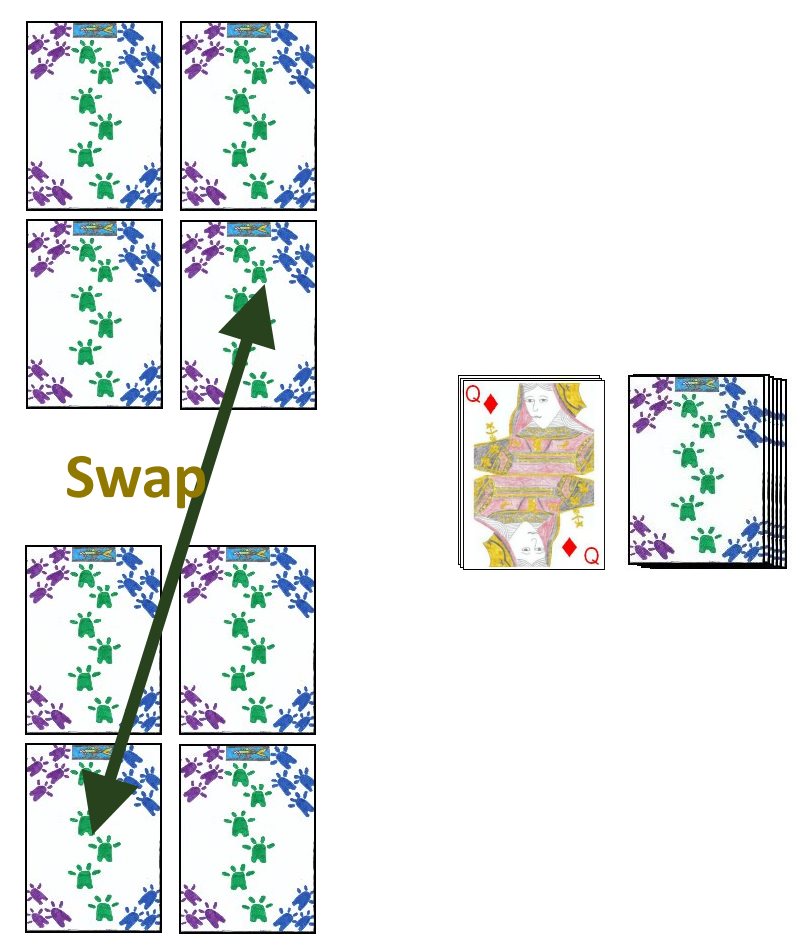
In addition to the differences in some of the card values and the special cards which can be played, another difference is the Sticking rule. Using this rule, if a player discards any card on the discard pile and any other player knows he has a card of the same rank in his layout, he may quickly take the card from his layout and place it on the discard pile on top of that previously discarded card. This is called Sticking. However, only one player may do this on a turn, so the first player who plays a card in this way is given this privilege. When doing this, the player who places his card on the discard pile in this way is allowed to continue the game with one fewer cards in his layout,
effectively having a score of 0 for that now empty space. A player may never Stick a card on his own discard. If a player sticks a card incorrectly (it is actually not of the same denomination) he must take the card back and also place one additional card face-down from the deck near his layout as a new penalty addition to his current layout. The value of this card will be added to his total for his layout at the end of the hand. In addition, if you do not necessarily have a card of the same rank as the last discarded card, but know of a specific card in an opponents card that does, you can take that card from the opponent's layout and Stick it on the discard pile. If the card is correctly of the same rank, the player who took the card from the opponent's layout may then fill that empty space in that opponent's layout with any card from his own layout (without looking at the card in his layout). However, if he attempts to do this with an opponents card and is incorrect, the card is returned to the opponent, however the player who attempted to Stick the card must add one penalty card from the stock to his own layout.
Another difference is that players may only use one hand for all play actions during the game (drawing cards, replacing cards,
etc.). If a player uses two hands, he must immediately draw one penalty card and add it to his own layout.
When a player believes he has the lowest total he calls "Cambio". He may take no other action on the same turn he makes the call of "Cambio". Each other player than
has one additional turn. After each other player has had one last turn, each player's layouts are turned over and compared. The player with the lowest total in the layout is declared the winner. If there is a tie amongst the players, and one of the players is the player who called "Cambio", the opponent of the player who made the "Cambio" call is the winner. If the tie is amongst other players, these players would tie for the win.
Pablo: Another variant of four card Golf which is played similar to the base game with the addition of special Power Cards is called Pablo. The value of the cards in the deck and the special effects they will have are as follows:
| Card | Point Value | Special Effect When Played |
|---|
| Ace | 1 | None |
| Joker | -5 | None |
| King, Queen, Jack | 10 | None. |
| 2, 3, 4, 5, 6, 9, 10 | Value marked on card | None |
| 7 | 7 | Drawing a 7 from the stock pile and then playing the card allows this player to look at any one card in any opponents layout and exchange one card from his own layout. The player may not look at the card from his own layout when performing the swap. When the card is played, it is placed in the discard pile. |
| 8 | 8 | Drawing an 8 from the stock pile allows the player to play that card to the discard pile, which entitles that player to look at any one card (without any other player seeing the face of the card) in any layout on the table. This may be a card in his own layout or a card in an opponent's layout. When the card is played it is placed in the discard pile. |
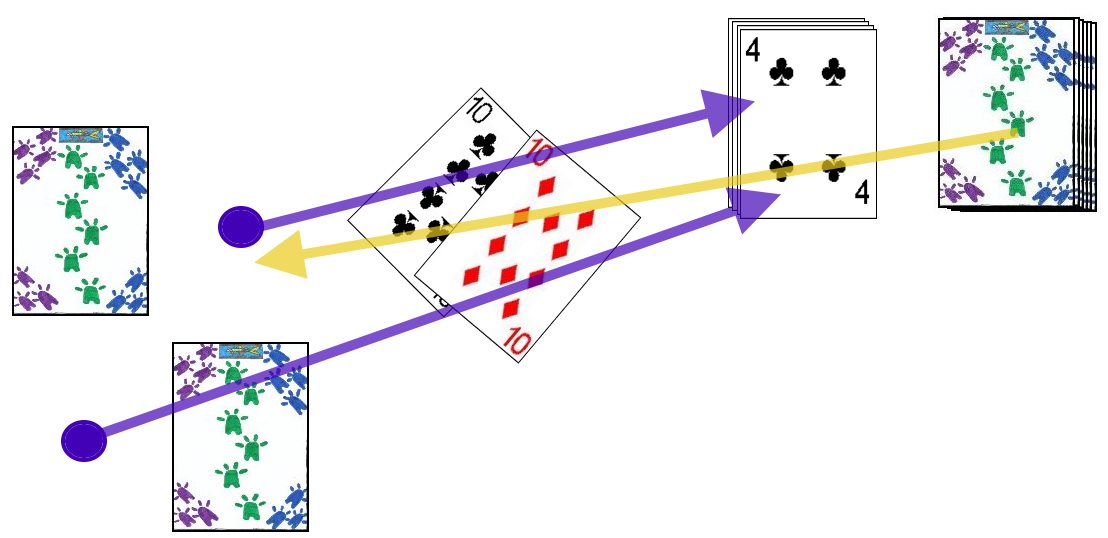
Similar to Cambio, this game has a few other differences as well:
- If a player believes he has two cards of equal rank in his own layout, he may use a card drawn from the stock to replace both these cards of equal rank with this one new card drawn from the stock. He does this by placing the two cards face-up on the discard pile and replacing them with the new card. This will leave the player with one fewer cards in his layout which will help reduce his total score. However, if the two cards replaced are not of equal value, the player must return the two cards removed from his layout and keep the replaced card, thus having a layout consisting of one additional card as a penalty.
- When a player believes he may have the lowest total in his layout, he
declares "Pablo" on his turn and may take no other action on that turn. Each
other player then has one more turn to attempt to reduce the point total of his
own layout. After each other player has had one last turn, every player's layout
is exposed and the totals compared. If the player who called "Pablo" does, in
fact, have the lowest total he is entitled to subtract 10 points from his
current score and every other player adds to their own score the total value of
their own layout. If another player has a lower total than the player who called
"Pablo" the player who made the call adds to his own score the value of his own
layout plus the value of the layout of the player with the highest total layout
on this hand, and every other player adds to his own score the total of his layout. If the player calling "Pablo" ties one or more other player for the lowest score, all players (including the player who called "Pablo") must add to their current score the value of his own layout.
- The game continues from hand to hand until one player reaches or exceeds 100 total accumulated points. The player who, at that time, has the lowest total score is declared the winner.
In all other aspects Pablo is played identically to the standard version of Golf as described above.
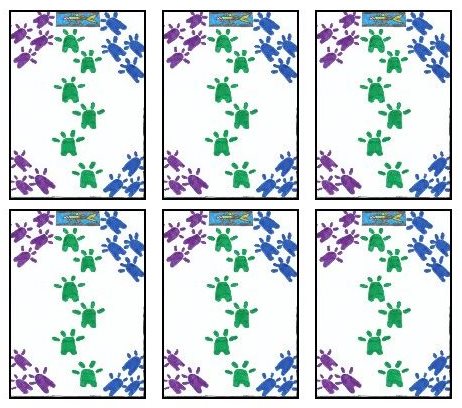 Six Card Golf:
Six Card Golf: Six card Golf is a very popular variant of the base game. This variant is sometimes known as Hara Kiri. This version features a six card layout for each player rather than four. This version is designed for 2 to 4 players using one standard 52 card deck. Determination of seating positions and the dealer can be done in the same method as the standard variant of the game.
Once the dealer has been determined,
he deals six face-down cards to each player starting with the player to
his immediate left, dealing the cards to each player to form that
player's layout. This layout should consists of a rectangle consisting of two rows of three cards each.
After each player has his six card layout dealt, the dealer places the remainder of the deck face down in the center of the table as the stock. He then turns over the top card of the stock, placing it face-up beside the stock pile to start the discard pile. The players may not look at the value of the cards in the layout, however they may select any two cards from the layout and turn them over, face-up. The player to the dealer's immediate left has the first turn.
On his turn a player may take one of two actions:
- Draw from Stock:
He may either draw the top card of the stock, discarding the card drawn or replacing any one card from your layout. The player may not look at the card from his layout before replacing it (if replacing a face-down card), simply placing the card to be replaced face up on the discard pile. The then takes the card drawn and places it face-up in the place previously occupied by the discard card with the new card.
- Take the Discard:
The player may take the top, exposed card from the discard pile, replacing any card from his layout. If replacing a face-down card in his layout, he may not look at the card to be replaced before replacing the card, he simply places the card to be replaced face-up onto the discard pile, placing the new card face-up in it's place.
Once any player, during his turn, has exposed every card in his layout (no
face-down cards remaining in his layout), each additional player then
has one last turn to attempt to lower the score in his own layout.
Scoring: The values of the individual cards in a player's layout are as follows:
|
|
|
| Card | Point Value |
|---|
| Ace | 1 |
| 2 | -2 |
| 3, 4, 5, 6, 7, 8, 9, 10 | Face value marked on card |
| Jack, Queen | 10 |
| King | 0 |
|
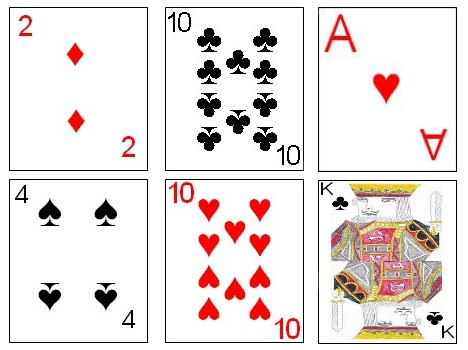
There is also one additional method to reduce the number of points in the layout. If any column in that player's layout contains two cards of the exact same rank (such as two 5's or two Queens), the total of those cards becomes 0. Note that this occurs for any two matching cards in these positions, including twos.
After nine total rounds (or holes) the player with the lowest accumulated total is declared the game winner.
To accommodate additional players, as in the standard variant, additional decks can be added to the game. to
accommodate up to 6 players two decks should be used, and to accommodate 7 or 8 players, three decks should be shuffled together for use in this game.
Eight Card Golf: Another variant of the card game Golf features each player with a layout consisting of eight total cards. The layout consists of a layout of two rows with four cards in each row. This version is designed to be played by up to 5 players using two full decks shuffled together. Other than the larger grid and greater number of cards in the deck, the gameplay is identical to that of six-card golf.
Ten Card Golf: Similar to Eight card Golf, a ten card variant is also sometimes played. This game is played identically to the six or eight card Golf variant, with the only difference being the size of each players layout. This game is usually played using two decks shuffled together, and can be played by up to 4 participants. Each player's layout consists of two rows of five cards each.
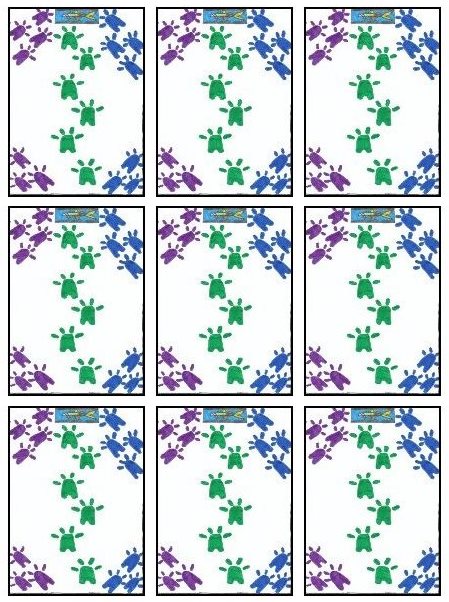 Crazy Nines:
Crazy Nines: Crazy Nines, also known as Nine Card Golf is another variant of Golf, this time featuring a layout consisting of nine total cards. The game is designed for two to four players using two standard 52 card decks shuffled together.
Thus, after shuffling, the dealer deals each player nine face-down cards, one-at-a-time. In this variant, he creates a face-down card layout consisting of three columns consisting of three cards each.
Before the hand begins, each player may turn all three cards in one column of his choice face-up. The turns are played exactly the same as in the six-card variant.
The goal of the game, as in most of the other games of this type is to have as low a score as possible in a player's layout at the end of each hand. The scoring of each card found in the layout is the same as in the standard four card game. If a player manages to fill all three cards in the same column with cards of the exact same denomination, that whole row counts as 0 points. To simplify the layout, these cards are sometimes set aside, out of play. In all other aspects this version of the game is played identically to the four-card variant.
Crazy Nines - Deluxe Scoring: Some players prefer to add several modifications to Nine Card Golf which can further server to allow a player to reduce his score during the hand by creating certain combinations in his layout.
- Additional Lines - In the normal variant, three cards of the same rank in a vertical line have a net score of zero. In this variant, in addition to vertical lines, having three cards of the same rank in a horizontal or diagonal line also score zero. When such a line of cards is formed in this way, all the cards used in the pattern are removed from that players layout, and the player continues play using the reduced size layout. This player no longer places any cards in the spaces which had formerly been occupied by the three cards of the same rank.
- Blocks - If a player manages to obtain a block of four cards in a 2 card by 2 card area of his layout of four cards of the same rank, this provides that player with a -25 score for those cards. After this score is records the four cards should be removed from that player's layout and the player continues play using this reduced layout. The player no longer places any cards in the spaces formerly occupied by the cards comprising the block.
In all other aspects this version is played the same as standard Crazy Nines.
Jokers: Some players prefer to add two Jokers to each deck used in the game. A Joker contributes a score of -2 to the layout. In versions of the game in which the twos are already scored at -2, the twos instead score 2 points to the hand with the Jokers scoring -2.
Ripple: Ripple is another game similar to Ten Card Golf, however it has some unique features of it's own to make it a definitely distinct game. Ripple is played using two standard 52 card decks shuffled together with the addition of four total Jokers. The game is designed for play by 2 to 6 players.
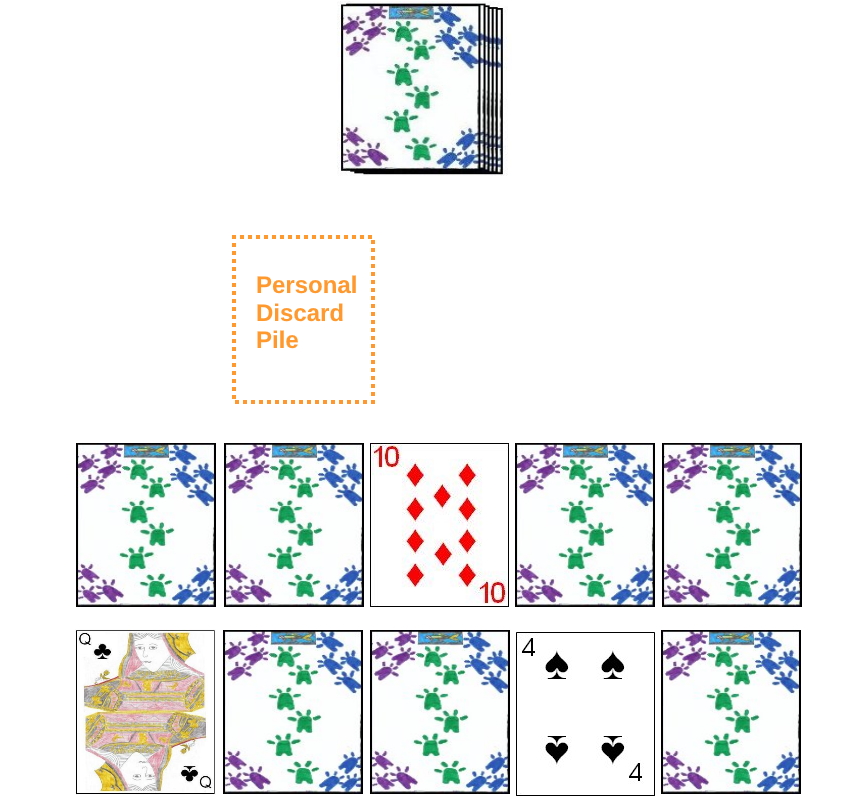
The setup for Ripple is similar to ten card golf with each player being dealt a ten card layout, consisting of two rows of five cards each, all face-down. The player is not permitted to view the faces of these face-down cards. The remainder of the deck is then set near the middle of the table as the community or common draw pile. After the cards have been dealt as appropriately, each players selects any three cards from his layout and is entitled to flip these over, causing these three cards to be exposed, face-up. After this, play of the hand begins. The player to the immediate left of the dealer has the first turn.
To start each player's turn, that player must draw a card. He may draw a card from either the face-down common draw pile or from any other player's discard pile. On the first turn of the game, no players will yet have personal discard piles, so the first player only has the option to draw from the common draw pile. The player may look at
the card so drawn. If the drawing player prefers not to use the card drawn, he may simply place it in his personal discard pile, face-up. If he has no such pile yet, he starts one with the discard. However, the player also has one of several other options he can take with his card.
- If the player so chooses, he may exchange the card drawn, replacing any of the cards which are still face-down in his layout. The new replacement card is played face-up in it's place and the previous face-down card is placed on the top of that player's personal discard pile, face-up.
- If the card drawn is the exact same denomination (such as a 5 for a 5 or a Queen for Queen) as another card in the layout, and the card directly above or below that card in that same layout is still face-down, the player may then replace that face-down card with the matching card. This forms a matching pair of cards. In addition, the player then looks at the card replaced, and if this card too, matches another (by rank) face-up card in that player's layout, and the card directly above or below this card is still face-down, the player may then replace that card with this card, creating another matched pair. He then reviews the new replaced card. He may continue making these exchanges (called The Ripple) as long as able. Once no more matches on his layout are possible, the player simply ends the turn by placing the replaced card face-up in his personal discard pile.
A player's turn ends as soon as he places a card in his personal discard pile.
The game continues in this manner from player to player, in a clockwise series of turns, until any player, at the end of his turn has no face-down cards in front of him (all being now face-up). After this occurs, he must announce this face and each other player has one more turn in which they can attempt to improve their hands as able. After each other player has had one last turn, the game ends and scoring occurs. Each player then exposes any remaining face-down cards in their layout, and scoring occurs for the hand. The following details the various scores that can be accumulated during the hand:
- For any complete pair, in which the top and bottom card in a column are the same denomination scores zero for those cards.
- If there is a block of four cards, all of the exact same rank and all adjacent to each other, this is called a Block Party, and this combination generates a total of -20 points for that player.
- If there are three matching pairs, all adjacent, and all of the same exact rank of cards, this combination of cards generates a total of -40 points.
- For a large block consisting of four matching pairs, all adjacent, and all of the same rank, this combination provides a
total -60 points for that player.
- Any cards that are not part of a pair or block, accumulates a positive score to that players ongoing total, as per the following chart:
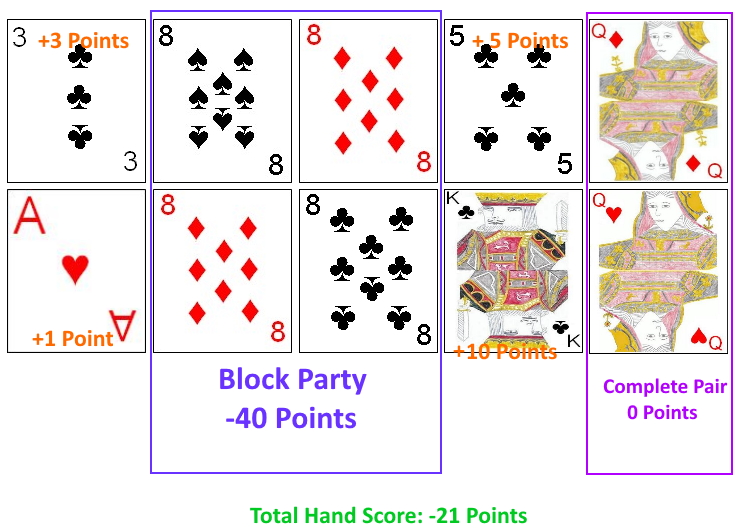 |
|
| Card | Point Value |
|---|
| Ace | 1 Point Each |
| 2, 3, 4, 5, 6, 8, 9, 10 | Point Value as Marked on Card |
| 7, Jack, Joker | 0 Points |
| Queen, King | 10 Points Each |
|
Each player's score for that hand is then added to that player's accumulated score over the entire game. Once any player's score reaches -100 or positive 100, the game immediately ends. The player with the lowest (or highest negative score) is declared the overall game winner.
Copyright © 2015 CatsAtCards.com. All rights reserved.

 Determination of the first dealer and seating positions can be performed using a number of methods, with drawing for low cards a common method. The players would take seats at the table in order based on the point value of the card drawn, from lowest point value to the highest. The player drawing the lowest point total card becomes the first dealer. If two or more players draw cards with the same point value, those players should discard the card and draw again, continuing to do so until drawing a card no other player has yet drawn.
Determination of the first dealer and seating positions can be performed using a number of methods, with drawing for low cards a common method. The players would take seats at the table in order based on the point value of the card drawn, from lowest point value to the highest. The player drawing the lowest point total card becomes the first dealer. If two or more players draw cards with the same point value, those players should discard the card and draw again, continuing to do so until drawing a card no other player has yet drawn.


 In addition to the differences in some of the card values and the special cards which can be played, another difference is the Sticking rule. Using this rule, if a player discards any card on the discard pile and any other player knows he has a card of the same rank in his layout, he may quickly take the card from his layout and place it on the discard pile on top of that previously discarded card. This is called Sticking. However, only one player may do this on a turn, so the first player who plays a card in this way is given this privilege. When doing this, the player who places his card on the discard pile in this way is allowed to continue the game with one fewer cards in his layout,
effectively having a score of 0 for that now empty space. A player may never Stick a card on his own discard. If a player sticks a card incorrectly (it is actually not of the same denomination) he must take the card back and also place one additional card face-down from the deck near his layout as a new penalty addition to his current layout. The value of this card will be added to his total for his layout at the end of the hand. In addition, if you do not necessarily have a card of the same rank as the last discarded card, but know of a specific card in an opponents card that does, you can take that card from the opponent's layout and Stick it on the discard pile. If the card is correctly of the same rank, the player who took the card from the opponent's layout may then fill that empty space in that opponent's layout with any card from his own layout (without looking at the card in his layout). However, if he attempts to do this with an opponents card and is incorrect, the card is returned to the opponent, however the player who attempted to Stick the card must add one penalty card from the stock to his own layout.
In addition to the differences in some of the card values and the special cards which can be played, another difference is the Sticking rule. Using this rule, if a player discards any card on the discard pile and any other player knows he has a card of the same rank in his layout, he may quickly take the card from his layout and place it on the discard pile on top of that previously discarded card. This is called Sticking. However, only one player may do this on a turn, so the first player who plays a card in this way is given this privilege. When doing this, the player who places his card on the discard pile in this way is allowed to continue the game with one fewer cards in his layout,
effectively having a score of 0 for that now empty space. A player may never Stick a card on his own discard. If a player sticks a card incorrectly (it is actually not of the same denomination) he must take the card back and also place one additional card face-down from the deck near his layout as a new penalty addition to his current layout. The value of this card will be added to his total for his layout at the end of the hand. In addition, if you do not necessarily have a card of the same rank as the last discarded card, but know of a specific card in an opponents card that does, you can take that card from the opponent's layout and Stick it on the discard pile. If the card is correctly of the same rank, the player who took the card from the opponent's layout may then fill that empty space in that opponent's layout with any card from his own layout (without looking at the card in his layout). However, if he attempts to do this with an opponents card and is incorrect, the card is returned to the opponent, however the player who attempted to Stick the card must add one penalty card from the stock to his own layout.
 Similar to Cambio, this game has a few other differences as well:
Similar to Cambio, this game has a few other differences as well:

 There is also one additional method to reduce the number of points in the layout. If any column in that player's layout contains two cards of the exact same rank (such as two 5's or two Queens), the total of those cards becomes 0. Note that this occurs for any two matching cards in these positions, including twos.
There is also one additional method to reduce the number of points in the layout. If any column in that player's layout contains two cards of the exact same rank (such as two 5's or two Queens), the total of those cards becomes 0. Note that this occurs for any two matching cards in these positions, including twos.

 The setup for Ripple is similar to ten card golf with each player being dealt a ten card layout, consisting of two rows of five cards each, all face-down. The player is not permitted to view the faces of these face-down cards. The remainder of the deck is then set near the middle of the table as the community or common draw pile. After the cards have been dealt as appropriately, each players selects any three cards from his layout and is entitled to flip these over, causing these three cards to be exposed, face-up. After this, play of the hand begins. The player to the immediate left of the dealer has the first turn.
The setup for Ripple is similar to ten card golf with each player being dealt a ten card layout, consisting of two rows of five cards each, all face-down. The player is not permitted to view the faces of these face-down cards. The remainder of the deck is then set near the middle of the table as the community or common draw pile. After the cards have been dealt as appropriately, each players selects any three cards from his layout and is entitled to flip these over, causing these three cards to be exposed, face-up. After this, play of the hand begins. The player to the immediate left of the dealer has the first turn.
